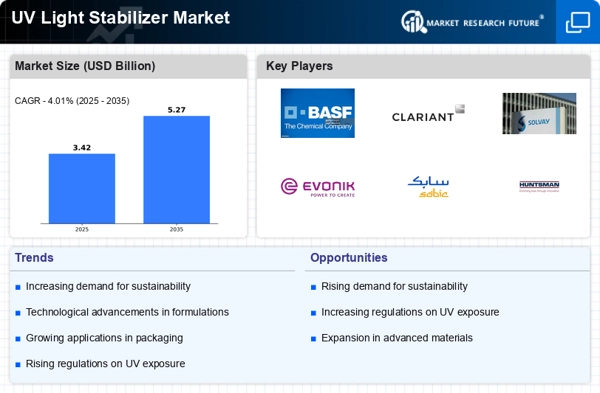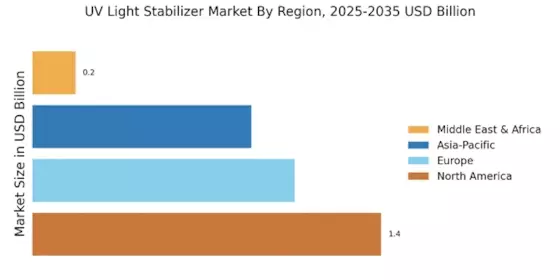Growth in the Packaging Industry
The UV Light Stabilizer Market is significantly benefiting from the growth in the packaging sector, which is projected to expand at a CAGR of around 4.2% in the coming years. This growth is primarily driven by the increasing demand for packaged goods, particularly in food and beverage, pharmaceuticals, and cosmetics. UV light stabilizers play a crucial role in protecting packaging materials from UV radiation, which can lead to discoloration and degradation. As brands seek to enhance the shelf life and visual appeal of their products, the incorporation of UV stabilizers becomes increasingly important. Furthermore, the rise of e-commerce and online retailing is likely to further propel the demand for durable and visually appealing packaging solutions, thereby driving the growth of the UV light stabilizer market.
Regulatory Compliance and Standards
The UV Light Stabilizer Market is influenced by stringent regulatory compliance and standards aimed at ensuring product safety and environmental protection. Various regions have implemented regulations that mandate the use of UV stabilizers in products to minimize harmful effects on both human health and the environment. For example, the European Union has established guidelines that require manufacturers to adhere to specific safety standards, thereby increasing the adoption of UV light stabilizers in various applications. This regulatory landscape not only compels manufacturers to incorporate UV stabilizers but also fosters innovation in the development of safer and more effective formulations. As a result, the market is likely to witness a surge in demand for UV light stabilizers that comply with these evolving regulations, ultimately enhancing product safety and sustainability.
Rising Demand for Durable Materials
The UV Light Stabilizer Market is experiencing a notable increase in demand for durable materials across various sectors, including construction, automotive, and consumer goods. As industries strive for longevity and performance, the incorporation of UV light stabilizers becomes essential to enhance the durability of products exposed to sunlight. For instance, the construction sector is projected to grow significantly, with a compound annual growth rate (CAGR) of approximately 5.5% over the next few years. This growth is likely to drive the demand for UV light stabilizers, as they protect materials from degradation, ensuring that products maintain their integrity over time. Consequently, manufacturers are increasingly investing in UV light stabilizers to meet the evolving needs of consumers who prioritize longevity and sustainability in their purchases.
Technological Innovations in UV Stabilizers
The UV Light Stabilizer Market is witnessing a wave of technological innovations that enhance the performance and efficiency of UV stabilizers. Recent advancements in polymer chemistry and formulation techniques have led to the development of new types of UV stabilizers that offer superior protection against UV radiation. These innovations not only improve the effectiveness of UV stabilizers but also expand their applicability across various industries, including automotive, textiles, and coatings. For instance, the introduction of nanotechnology in the formulation of UV stabilizers has shown promising results in enhancing their performance. As manufacturers continue to invest in research and development, the market is likely to see a proliferation of advanced UV stabilizers that meet the diverse needs of end-users, thereby driving market growth.
Increasing Awareness of Environmental Impact
The UV Light Stabilizer Market is increasingly influenced by the growing awareness of environmental impact among consumers and manufacturers alike. As sustainability becomes a focal point in product development, there is a rising demand for eco-friendly UV stabilizers that minimize environmental harm. This shift is prompting manufacturers to explore bio-based and biodegradable alternatives to traditional UV stabilizers, which may contain harmful chemicals. The market is likely to see a transition towards more sustainable options, driven by consumer preferences for environmentally responsible products. Additionally, regulatory bodies are also encouraging the use of sustainable materials, further propelling the demand for eco-friendly UV stabilizers. This trend not only aligns with global sustainability goals but also positions manufacturers to meet the expectations of a more environmentally conscious consumer base.

















Leave a Comment